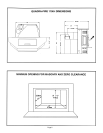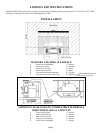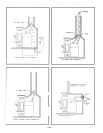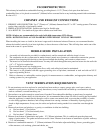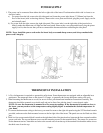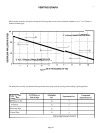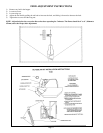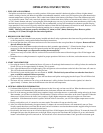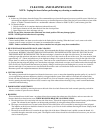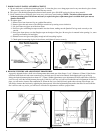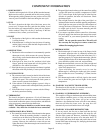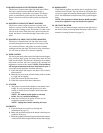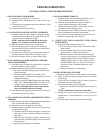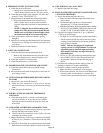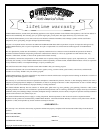1. FIREPOT
A. It takes very little time to clean the firepot. We recommend that you clean the firepot at least once a week. However, if the fuel you
are burning has a high dirt content, it will be necessary to clean the firepot more often. Dirty fuel will cause clinkers to form in the
firepot. A clinker is formed when dirt or a nonburnable substance is heated to 2000°F (1093°C) and becomes glass-like.
B. To clean the firepot:
1. Wait for insert to be in complete shutdown (exhaust blower off).
2. Pull firepot cleanout rod out, then ride back into the closed position.
3. Open firepot access door and empty ash tray.
NOTE: Do not allow cleanout rod to slam back into closed position. This may damage igniter.
NOTE: NEVER pull rod when insert is operating.
2. FIREBOX ASH REMOVAL
Clean as needed. Make sure there are no hot ashes in the firebox before cleaning. When the insert is cool, remove ash with a
vacuum or small scraper, and place it in a metal or noncombustible container.
NOTE: Embers remain hot for many days. Store container in a safe place away from combustibles.
3. HEAT EXCHANGER MAINTENANCE AND CLEANING
There is one cast finned heat exchanger in this insert. We recommend that this heat exchanger be cleaned at least once for every ton
of fuel burned. BEFORE CLEANING THE HEAT EXCHANGER, THE INSERT MUST BE COLD TO THE TOUCH AND
THE POWER MUST BE DISCONNECTED. The heat exchanger is located on the right side of the insert. To clean the heat
exchanger, open the main door and remove the stainless steel cover. It has one tab at the rear of the cover. The cover must be lifted
approximately 1/2” (13mm) and pulled away from the heat exchanger. Now open the bottom access door. On the right side of the
firepot, there is a metal cover plate with two screws. Turn both screws counterclockwise, until they stop. Then remove cover plate
by grasping the front edge and pulling out. Clean the heat exchanger with a brush or scraper, and vacuum out the ashes through the
lower access hole. Then reinstall the bottom cover plate by sliding it back into place and turning the two screws in a clockwise
direction until tight. Close bottom access door. Reinstall the stainless steel cover inside the firebox and close the main door.
Reconnect power and readjust thermostat to desired temperature.
4. VENTING SYSTEM
The venting system should be inspected and cleaned at least once a year, or more often depending upon the quality of your fuel. If
you are experiencing nuisance shutdowns, check for a clogged exhaust system. If the exhaust is restricted, the vacuum safety
switch will shut the feed motor off (the red light will remain on). You can clean the venting system without removing it from the
insert by opening the small hinged access door, located on top of the exhaust blower housing. Using a small vacuum attachment,
vacuum the exhaust housing.
5. DOOR HANDLE ADJUSTMENT
The door latch is adjusted by removing the nut on the back of the door latch. Remove the latch cam and square key, and add or
subtract a washer to space the cam as needed.
6. BLOWERS
There are three blowers in this insert: an exhaust blower that evacuates the exhaust out of the firebox, and two convection air
blowers that delivers heat into the room. THESE BLOWERS REQUIRE NO LUBRICATION.
A. The exhaust blower is located at the left rear side of the insert. It should be inspected during the annual cleaning of the exhaust
system. The exhaust blower impellers can be inspected periodically by using the exhaust blower cleanout door.
B. The larger convection blower is located on the front left side of the insert, and is accessible by removing the front left panel.
The impeller on this blower should be cleaned at least once a year. You can do this without removing the blower. Simply brush
and vacuum the impeller area.
C. The small convection blower is located at the rear right side of the insert. When the insert is pulled out onto the hearth, it is
accessible through a removable access panel. The impeller on this blower should also be cleaned at least once a year, and can
also be cleaned in place.
CLEANING AND MAINTENANCE
NOTE: Unplug the insert before performing any cleaning or maintenance
Page 13



